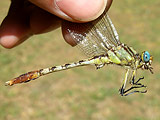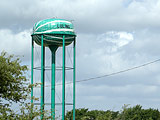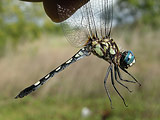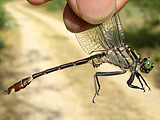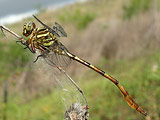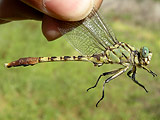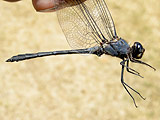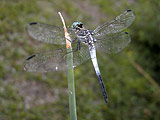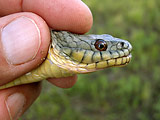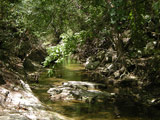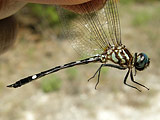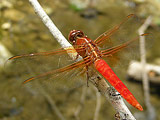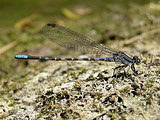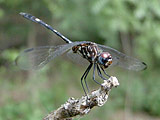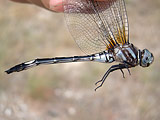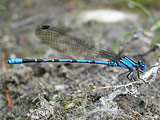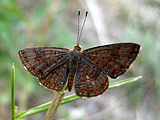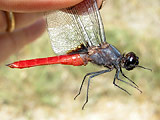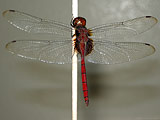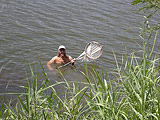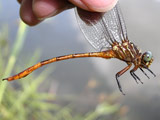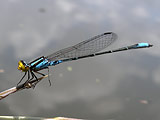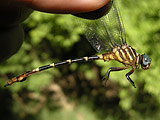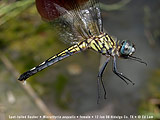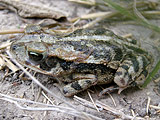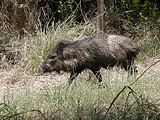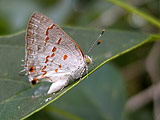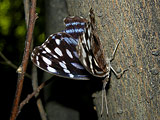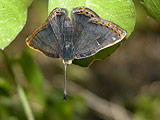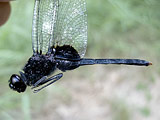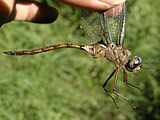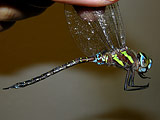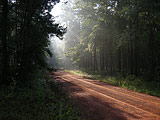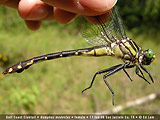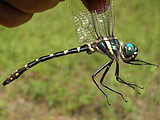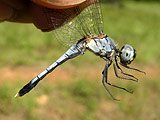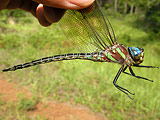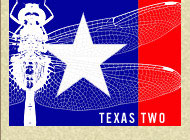
Texas, June 7-20, 2008
A lot happened during this two week trip to Texas. I saw a lot of exciting dragonflies and hit most of my targets. While seeking a dragonfly newly added to the U.S. list, we found another U.S. record. But it was one of the most grueling trips I've taken so far, long hot days with triple digit temperatures and high humidity, sleep deprived nights scanning, and long driving distances between locations. And there were the calls home. Worried how the boys would adjust to the new sitter (not too well). Then it rained at home and the lights went out and my basement and studio flooded (again) only I wasn't home to help clean it up.
Saturday, June 7:
Air travel these days is a nightmare. Mine began the day before when I got an automated phone message informing me that my flight was already cancelled. I was rebooked on a later flight so I would get into Austin at 1:30 PM instead of 12:30 PM. Still that should be enough time to get in the field for a couple of hours. The nightmare continued with a call waking me up at 5 AM from American Airlines saying my rebooked flight was also cancelled and now I was on a flight to Chicago. Not only was the connecting flight to Austin scheduled to arrive later (3:30, now little time in the field) but the first flight was to take off earlier in the morning so I had to get up and get moving. I held on the line and got a real person to yell at although it didn't make me feel any better or get me a reasonable explanation.
I had to call to wake up Fabrice de Lacour who was accompanying me on the trip so he could get going earlier. We got to LaGuardia and waited. Suffice it to say we did not get to Austin at 3:30 and we did not make it into the field. However Giff Beaton visiting from Georgia and Greg Lasley of Austin did and they had caught me a couple of local species I wanted to see, Four-striped Leaftail Phyllogomphoides stigmatus and Broad-striped Forceptail Aphylla angustifolia. We met up them and John and Kendra Abbott at Greg's house for pizza and beer, a fine way to unwind after our air travel ordeal.
Sunday, June 8:
Greg and Giff picked us up at our motel the next morning and we headed off to look for Stillwater Clubtail Arigomphus lentulus at the only site that Greg knew for it. He had seen them less than a week before so they should still be flying. It was a little farm pond or "tank" as the locals call them. Only one edge of the tank was accessible by the road while the rest of the pond was behind a barbed wire fence. We combed the road edge, flushing up a couple of deer fawns, found a Sulphur-tipped Clubtail Gomphus militaris and some Setwings Dythemis species but no Stillwater Clubtails. As we were just about to give up Fabrice and I spotted a couple of clubtails flying at the pond edge but on the other side of the fence. It took some doing and coordination but we did manage to net a couple of males.
We headed back towards Austin making a couple of stops for Jade-striped Sylph Macrothemis inequiunguis. Again Greg had scouted them during the previous week and found some that were flying. An odd, tiny species, males patrolled forest clearings where they would disappear from view into the shade. We saw a couple flying high among the treetops. One surprised us by flying low but he escaped without a swing. Fabrice having gone down into the stream, caught a female laying eggs underneath the tunnel of the road crossing but we left without catching a male.
We made a couple more stops at parks in and around Austin in the afternoon before calling it a day. We saw a good number of species including many Four-striped Leaftails and some of the Texas variety of Cobra Clubtail Gomphus vastus. The Cobras here have reduced pale spots on a very brown club.
Monday, June 9:
We returned to Southeast Metro Park in the morning to look for Jade Clubtail Arigomphus submedianus at a small pond there. It was frustratingly windy (especially for the photographers) and we had little luck at first. Giff spotted a Jade that flew off. I waited around the pond catching a couple of male Broad-striped Forceptails which I needed then finally caught a male Jade Clubtail after stalking him as he flew from bush to bush.
Giff had to head back home and work so after dropping him off at the airport, Greg drove us all the way to San Antonio to look for Gray-waisted Skimmer Cannaphila insularis which Martin Reid had seen at a park on the San Antonio River the day before. We found several males on a little shady stream. We thought we had a female by the river itself (more the size of a small creek) but it turned out to be an immature male. We saw a few other interesting species including Slough Amberwing Perithemis domitia, a variety of Dancer (Argia) species, and a intriguing Forceptail that flew away unidentified.
Tuesday, June 10:
Tuesday was a travel day but Fabrice and I made one stop for a male Jade-striped Sylph in the morning. We arrived early at Walnut Creek Park where we had seen them flying on Sunday. We were hoping to find a male feeding lower to the ground but intially we didn't see anything but Setwings. Later I saw a single male Sylph flying high above a clearing then nothing for quite a while. The morning was frustratingly cloudy. Along the trail I caught a female Pale-faced Clubskimmer Brechmorhoga mendax then let her go. I went back to the stream and passed some time taking pictures of Dancers, Kiowa immunda, and Springwater plana. I was photographing a Neon Skimmer Libellula croceipennis when a female Jade-striped Sylph landed in a nearby tree, her dark wing tips conspicuous. After she flew off I went looking for Fabrice to see what he had found. He had been watching two male Sylphs flying high above a wooded trail. We kept an eye on them for a long while but they did not come lower and eventually they disappeared as the sun and temperature rose. Later as I was making my way through a narrow trail I saw a little movement in the shade as a small dragonfly flew and hung up in the twigs. It was a male Sylph and I cursed the close branches that I feared would get in the way of the net.
Having caught the Sylph we headed south towards the lower Rio Grande Valley a little over 300 miles away. Exciting things had been seen recently and we were anxious to get there.
Wednesday, June 11:
The most exciting dragonfly we were hoping to see was Scarlet-tailed Skimmer Planiplax sanguiniventris a species new to the U.S. that had been discovered on June 2 at Bentsen - Lower Rio Grande Valley State Park. It was initially thought to be the similarly patterned Flame-tailed Pondhawk Erythemis peruviana but photographs taken by Martin Reid and David and Jan Dauphin proved otherwise.
Fabrice and I were wading the resaca lake at Bentsen Wednesday morning. We were told the Planiplax did not appear at the water until 10:30 AM but we tried earlier anyway. Fabrice caught a dragonfly that we thought at first was out target. Like the Planiplax it had a red abdomen and a dark wing patch at the base of the hind wing but nothing else was right. Later we caught a real Planiplax and the differences were stark. But we couldn't put a name on it. It also behaved quite differently, the Planiplax occasionally perched but our mystery dragonfly was a flier. I thought it might be Garnet Glider Tauriphila australis, a species recorded a few times in Florida which I have not seen alive so I was unsure. We put it aside to examine later.
The afternoon grew hot. We looked for Carmine Skimmer Orthemis discolor but found none at the spots I saw them in April. Later we went looking for Black Pondhawk Erythemis attala, Turquoise-tipped Darner Rhionaeshna psilus, and Ringed Forceptail Phyllocycla breviphylla. We saw a male pondhawk but it got away, but found both sexes of Three-striped Dasher Micrathyria didyma. As I watched Fabrice try to net a Ringed Forceptail, I felt something biting at my ankles. Fire ants were attacking my legs. I jumped around trying to swat them all off but I got bit badly. Despite a generous application of DEET we were also plagued by mosquitoes. And chiggers. And ticks. I'm still itchy.
Going through the literature and my library of photographs that evening we quickly identified our mystery dragonfly. It was in the same genus as Garnet Glider (a good guess though) but a new species to the U.S. That night I sent out an e-mail to various experts:
Sent: Thursday, June 12, 2008 1:07 AM
Subject: Bentsen Planiplax collected plus another interesting species
Hi All,
Yesterday (Wednesday, June 11) Fabrice de Lacour and I managed to collect (under permit) a male Planiplax near the boatlaunch at Bentsen State Park in south Texas. We saw at least 5 individual males along a 250 yard stretch of the lake. They were difficult to catch as we had to wade in the waist to chest deep water along the shoreline vegetation.
During our Planiplax hunt, Fabrice also netted a reddish dragonfly male whose identity initially eluded us. We saw at least 3 other individuals. I have posted photographs taken in the hand, a dorsal scan and scans of the appendages. We believe that it is yet another new species for the U. S. but would like confirmation.
The next night we posted our find to the TexOdes and Odonata-1 lists:
Subject: Another U. S. record at Bentsen
From: Azurebluet AT aol.com
Date: Fri, 13 Jun 2008 02:37:24 EDT
Fabrice de Lacour and I are currently in the middle of a two week trip to observe, photograph, and collect dragonflies in Texas. We spent the first couple of days in the Austin area then headed to the Lower Rio Grande Valley on Tuesday. We had been following with great interest the recent string of "firsts" for the Valley particularly the first U. S. record of Planiplax sanguiniventris at Bentsen-Rio Grande Valley State Park. Under permit from Texas State Parks we sought to collect a specimen of the Planiplax for the Odonate Survey of Texas at the University of Texas.
So on Wednesday morning, June 11, we were wading in La Parida Banco resaca in Bentsen State Park just west of the boatlaunch where Planiplax has been seen. This species has a dark gray thorax, a bright red abdomen, and dark patches at the base of the hindwing. On the resaca there were a number of dragonfly species flying that are somewhat similar in color and pattern including two Tramea species, Libellula needhami, Dythemis fugax, Orthemis ferruginea, and lots of Brachymesia furcata.
Fabrice netted a dragonfly with a red abdomen, dark patches on the hindwing, but the thorax was a deep red. We puzzled over its identity. It certainly was not the Planiplax which we later did manage to collect. I suggested it might be Tauriphila australis Garnet Glider but consulting our trusty Needham, Westfall, and May, it's strongly curved cerci identified it as Tauriphila argo, a neotropical species not previously known to the U.S. The common name listed in NWM is Bow-tailed Glider.
We returned to the site the next morning, June 12, and observed at least 2 dozen male Tauriphila. We saw tandem pairs that could have been this species but were unable to catch any. Males fly short beats along the water's edge often chasing and being chased by other dragonfly species. They were best observed while wading but probably can be spotted through the considerable screen of cane along the shoreline.
Additionally we observed 5 male Planiplax on June 12.
Friday, June 13:
We headed to Santa Ana NWR in the morning but found it disappointingly dry and we worked around what little water was there. I had obtained a permit to survey there and felt bad that I really couldn't do any work for them. Our best sighting was a Bobcat and a youngster that wouldn't flush from a cool shady spot. In the late afternoon we concentrated on finding Turquoise-tipped Darner managing to catch a couple of females along an irrigation ditch near Bentsen.
Saturday, June 14:
We were back at Bentsen at the resaca in the morning looking for female Planiplax and Tauriphila. Fabrice kept cool wading the circumference of the lake while I walked some nearby trails and fields. I saw a couple of Bow-tailed Gliders circling over a field and netted one but it was a male. Fabrice found them common all around the lake so there is quite a population in the park. Also at the resaca were good numbers of Narrow-striped Forceptails Aphylla protracta, Tawny Pennant Brachymesia herbida, and Spot-tailed Dasher Micrathyria aequalis. I caught a female Spot-tailed ovipositing alone on the lake but found several more in the shade of the trees along the shoreline.
Having caught females the day before we tried for male Turquoise-tipped Darners. Fabrice caught a surprise Black Pondhawk but the darners continued to elude us. We would see them flying and hanging up but approaching them through the brush and down slippery muddy ditches was difficult. Finally I caught a young male that just happened to land next to me. I went to find Fabrice and found he had just caught a mature male. Thoroughly mosquito-bitten we were happy we didn't have to try again at this site.
We also caught the weird dragonfly. It hung up in the shade just like the darners. It was darner-sized, the body was pale tan and it had just the barest wing markings, a small dark triangle at the wing base and amber wing tips. Green eyes. We didn't recognize it and we thought we had something really good. Another U.S. record? The wing venation placed it in the Emerald family but what was it? While Fabrice was photographing it in the motel room it briefly got free. As it flew around the room it's shape and wing pattern suddenly seemed very familiar. I compared it to the scans of Prince Baskettail Epitheca princeps that I had on my laptop. It's structure matched but it's coloration made it the strangest individual I've ever seen.
Sunday, June 15:
We were pretty wiped out at this point. The heat, humidity, and the lack of sleep was getting to us. We thought we would sleep later but Martin Reid called us from the Bentsen visitor center where he was looking at a female Claret Pondhawk Erythemis mithroides. We got there as quick as we could but the pondhawk was gone. I had a Bow-tailed Glider flying right outside the visitor center. I was hoping it was a female but I somehow missed catching it. (Later in the week Martin would find more female Gliders foraging nearby and catch a female Claret Pondhawk). We weren't so fortunate but perhaps with the large numbers of Gliders present this population will persist until we make another visit.
Monday, June 16:
We made a half-hearted search for the Claret Pondhawk at the Bentsen visitor center then visited the McAllen Nature Center hoping for a female Gray-waisted Skimmer. We found the Golden-winged Dancers Argia rhoadsi reported there and we did see some Gray-waisteds along the stream but could not catch any. We then drove the 400 miles to the town of Cleveland, north of Houston and near Sam Houston National Forest.
Tuesday, June 17:
I dropped Fabrice off at the Big Creek Scenic Area in the National Forest then headed back to the motel where I had left my camera. When I got back he had caught a female Gulf Coast Clubtail Gomphus modestus. It the morning gloom it was flying over the creek and would be the only one we would find. Our main target for the area was Texas Emerald Somatochlora margarita. We didn't see any flying along the dirt roads so we tried a couple of wide trails through the woods. Along one of the trails we saw the narrow-waisted profile of an emerald flying high. We tried a number of locations throughout the long sultry day but saw very little.
Wednesday, June 18:
We concentrated on the one trail where we had seen a couple of emeralds. We had some tantalizing flybys in the late morning. They were erratic but low. Emeralds for sure but what species? Mocha Emerald Somatochlora linearis was also present but it is a larger and longer bug. The few flying high seemed small and were almost certainly margarita. We passed the time trying to catch Georgia River Cruisers Macromia illinoiensis georgina and comparing the females and immature males of various species of Skimmer Libellula that were along the trails. In the late afternoon I finally caught an emerald but it was a Mocha.
Thursday, June 19:
We tried one last time for Texas Emerald in the morning. We saw a couple flying high at a clearing early - then nothing. For a couple of hours we scrutinized small gatherings of Wandering and Spot-winged Gliders Pantala flavescens and hymenea but none had the right spindle-shaped abdomen of an emerald. Occasionally a Black Saddlebags Tramea lacerata would join them, a River Cruiser Macromia would cruise by or a Swamp Darner Epiaeschna heros would fly in and terrorize the Gliders. We made one last slow drive down the dirt forest roads and we spotted one male Texas Emerald coursing a small pattern in the sky. We watched it for 20 minutes before it flew off, never coming low enough for a swing.
Reluctantly we had to give up, our one true miss of the trip, and began driving towards Austin. We headed to San Antonio for another chance of finding a female Gray-waisted Skimmer. While we were down in the Valley, Greg had revisited the site and seen females early in the morning then observed as they were eventually displaced by males. We thought we try on our last morning, Friday, but since we arrived in San Antonio at 5:30 PM we took a look at the park. Almost immediately we found several females by the river so we were done.
I got on the phone and arranged to meet Martin Reid in the park. We were picking up his recent specimens to give to John Abbott in Austin. He had collected a female Bow-tailed Glider and Claret Pondhawk and I wanted to see, photograph, and scan them. How I would have liked to see them alive! We talked with Martin for a while, said our "Goodbyes" and headed back to Austin.
Friday, June 20:
Greg stopped by our motel the next morning to pick up Martin's specimens for John. We also gave him our specimens of the first Planiplax sanguiniventris and Tauriphila argo collected in the U.S. Not bad. Greg headed that day to Gonzales, TX where he found a couple of female Blue-faced Ringtails Erpetogomphus eutainia a beautifully patterned species I hope to see when I head back to Texas later this summer.
We didn't go into the field that morning but hung out at a bookstore before heading to the airport. Air travel is a nightmare these days.
I are truly grateful for the generosity, assistance, guidance, and companionship provided by Fabrice de Lacour, John Abbott, Greg Lasley, Giff Beaton, Martin Reid, David and Jan Dauphin, Josh Rose and the staff at Bentsen LRGV State Park and Santa Ana NWR. Thanks to David Riskind for granting permission to collect at Texas State Parks and Mitch Sternberg for permission to collect at Santa Ana/LRGV NWR.
